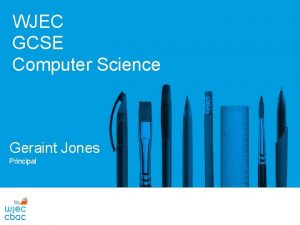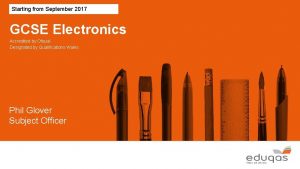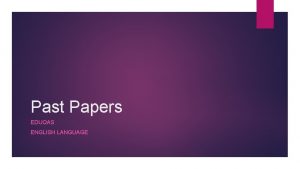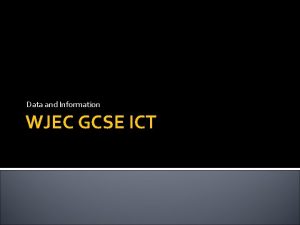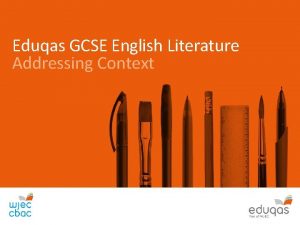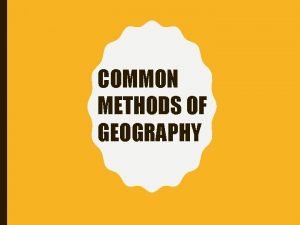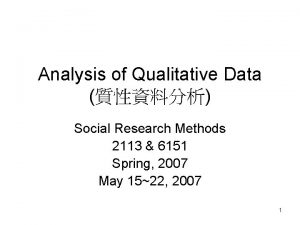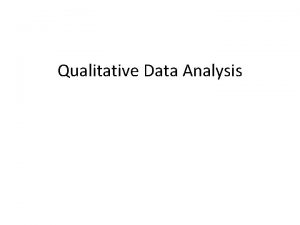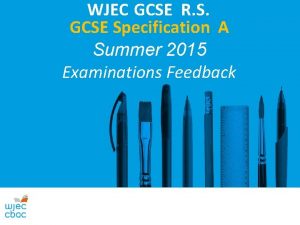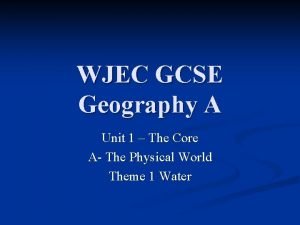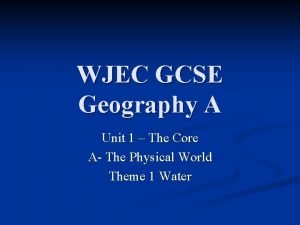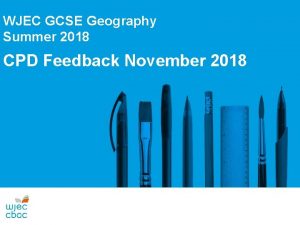WJEC GCSE in Geography Qualitative data What is










- Slides: 10

WJEC GCSE in Geography Qualitative data

What is qualitative data? traffic survey field sketch photos Bipolar Qualitative wind speed Quantitative Likert interviews discharge Qualitative research collects information Some qualitative research methods that is not numerical. Evidence can be sometimes use number scales so that collected in the form of text, oral responses can be put into rank order. accounts, interviews or images. Bipolar and Likert surveys are two Quantitative research collects evidence examples. WJEC recommends that these that can be counted or measured. For are used as examples of qualitative example, traffic surveys or measuring research as GCSE level. river discharge or wind speed.

Bipolar surveys use opposite adjectives or opposite descriptors. Students can be involved in selecting or writing appropriate bipolar statements. Groups of students can create banks of common statements so that larger datasets can be collated. Bipolar statements can be used to capture the viewpoints of the students themselves or of members of the public. They can be used to investigate whether different groups of people hold similar or different opinions. This beach is: Easy to access Difficult to access Safe Dangerous Clean Dirty Crowded Uncrowded Beautiful Unattractive Special Ordinary

Likert surveys assess the strength of response to an issue. They can be used to investigate whether different groups of people hold similar or different opinions. They are useful in fieldwork that investigates opinions about concepts such as place, sustainability or risk. The tors help create an important sense of identity in this landscape: Strongly agree Agree Neither agree or disagree Disagree Strongly disagree

Images Students can collect primary evidence in the form of photos, sketches and sketch maps. Field sketches and sketch maps have the advantage of only focussing on the important features of the landscape. Images collected during primary data collection should be located. Apps can be used to date, locate and add information about altitude. Images can be analysed using annotation. My Altitude app

Using re-photography to investigate changing places Changes to landscape (physical and human) can be evidenced by re-photographing an historic image. Postcards, available to view or purchase from online auction sites, provide a useful source of images that are dated and can be up to 110 years old. This one is dated 1946.

Clone towns A retail investigation of place could focus on clone towns. A clone town survey could be supplemented by: • Measuring flows of shoppers – are independent shops more or less popular than chain stores? • Questionnaires with shoppers – are independent shops important? If so, why? • Secondary data for rateable values of shops (per square metre) could be collected – are chain stores or independent shops paying higher rates?

Using re-photography to investigate clone towns Google Street View provides a free source of images starting in about 2009. By re-photographing street scenes, students can investigate whethere has been an increase or decrease in independent shops.

Processing and presenting data Photographs and other images can be annotated. Text can be analysed for the frequency of key words. These can be presented in a word cloud. Bi-polar scales can be presented using bar charts (with positive and negative scales) or multiple criteria can be shown on radar charts. What are the strengths & limitations of each of these techniques? Source of text: Visit Pembrokeshire www. wordclouds. com

Can I use transects? Yes! Transects could be used to: • Collect photographs of a significant landscape feature (coastline, river or human feature) at increasing distance to assess its importance within the wider landscape. • Conduct a bipolar survey at systematic intervals through a town centre. This means you don’t have to reinvent the wheel each year when the methodological approach changes.
 Gcse computer science wjec
Gcse computer science wjec Eduqas electronics a level
Eduqas electronics a level Eduqas english literature past papers
Eduqas english literature past papers Wjec gcse ict
Wjec gcse ict Unseen poetry eduqas
Unseen poetry eduqas Gcse media studies past papers
Gcse media studies past papers Qualitative data in geography
Qualitative data in geography Qualitative data ap human geography definition
Qualitative data ap human geography definition Quantitative data vs qualitative data comparison
Quantitative data vs qualitative data comparison Qualitative data quantitative data
Qualitative data quantitative data Gcse geography manchester case study
Gcse geography manchester case study
